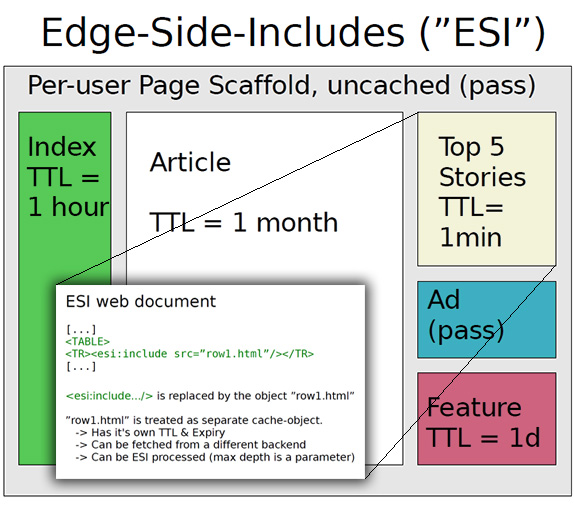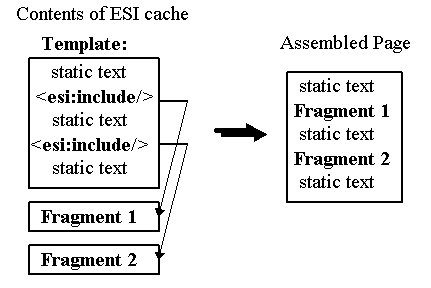ESI
go-esi
go-esi is the implementation of the non-standard ESI (Edge-Side-Include) specification from the w3. With that you'll be able to use the ESI tags and process them in your favorite golang servers.
What are the ESI tags
The ESI tags were introduced by Akamai to add some dynamic tags and only re-render these parts on the server-side. The goal of that is to render only specific parts. For example, we want to render a full e-commerce webpage but only the cart is user-dependent. So we could render the "static" parts and store with a predefined TTL (e.g. 60 minutes), and only the cart would be requested to render the block.
There are multiple esi tags that we can use but the most used is the esi:include because that's the one to request another resource.
We can have many esi:include tags in a single response, and each esi:include tags can itself have one or more esi:include tags.

We can have multiple esi:include tags in the page to request another resource and add its content to the main page.

References
https://www.w3.org/TR/esi-lang/
Install
go get -u github.com/darkweak/go-esi
Usage
import (// ...github.com/darkweak/go-esi/esi)//...func functionToParseESITags(b []byte, r *http.Request) []byte {// Returns the parsed response.res := esi.Parse(b, r)//...return res}
Available as middleware
- Caddy
- Træfik
- Roadrunner
Caddy middleware
xcaddy build --with github.com/darkweak/go-esi/middleware/caddy
Refer to the sample Caddyfile to know how to use that.
Roadrunner middleware
To use the go-esi processor as Roadrunner middleware, you just have to follow the steps below.
You have to build your rr binary with the go-esi dependency.
[velox]build_args = ['-trimpath', '-ldflags', '-s -X github.com/roadrunner-server/roadrunner/v2/internal/meta.version=v2.12.0 -X github.com/roadrunner-server/roadrunner/v2/internal/meta.buildTime=10:00:00'][roadrunner]ref = "v2.12.3"[github][github.token]token = "GH_TOKEN"[github.plugins]logger = { ref = "v3.2.0", owner = "roadrunner-server", repository = "logger" }esi = { ref = "master", owner = "darkweak", repository = "go-esi", folder = "middleware/roadrunner", replace = "/opt/middleware/roadrunner" }server = { ref = "v3.2.0", owner = "roadrunner-server", repository = "server" }gzip = { ref = "v3.2.0", owner = "roadrunner-server", repository = "gzip" }http = { ref = "v3.2.0", owner = "roadrunner-server", repository = "http" }[log]level = "debug"mode = "development"
After that, you'll be able to set enable and add the esi processor to the middleware chain.
# .rr.yamlhttp:# Other http sub keysesi: {}middleware:- headers- gzip- esi
Træfik middleware
# anywhere/traefik.ymlexperimental:plugins:souin:moduleName: github.com/darkweak/go-esiversion: v0.0.6
# anywhere/dynamic-configurationhttp:routers:whoami:middlewares:- esiservice: whoamirule: Host(`domain.com`)middlewares:esi:plugin:esi: {}
Refer to the sample traefik file to know how to use that.
TODO
- choose tag
- comment tag
- escape tag
- include tag
- remove tag
- otherwise tag
- try tag
- vars tag
- when tag